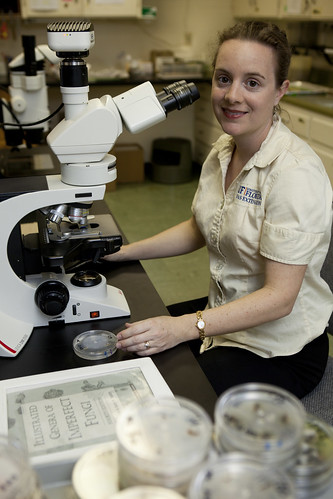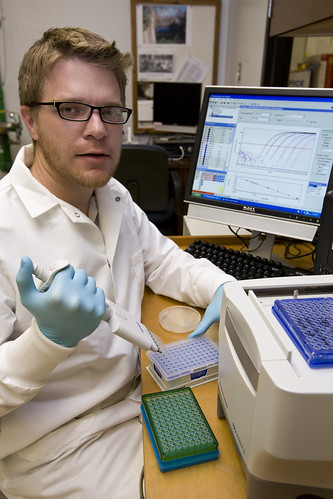
Carrie Harmon works at University of Florida’s Institute of Food and Agricultural Science labs with the National Plant Diagnostic Network. Photo courtesy of Ray Hammerschmidt
With support from the U.S. Department of Agriculture’s National Institute of Food and Agriculture (NIFA), the National Plant Diagnostic Network has grown into an internationally respected consortium of plant diagnostic laboratories dedicated to enhancing agricultural security by protecting health and productivity of plants in agricultural and natural ecosystems.
Dr. Ray Hammerschmidt, President of the National Plant Diagnostic Network, discusses this partnership and the benefits all Americans receive in the following guest post:
Superheroes really do work among us. But, instead of capes and cowls and ice palaces and caves, they are often found in a lab at a public university or state agriculture department, wearing lab coats and working over a microscope.
These men and women work daily to protect our communities and crops from dangerous pests and pathogens. They are plant pathologists, entomologists, nematologists, weed scientists, and other plant scientists who work diligently to mitigate the impact of endemic, emerging, and exotic pathogens and pests that attack agricultural, forest, and landscape plants in the United States.
We live in a global society where people, food, and materials travel in and out of our country 24 hours a day. In addition to natural introduction of pathogens and pests – such as the hurricane that brought soybean rust to the United States – our ports, highways, and airports are also entryways for new insects and diseases that hop a ride on cargo containers, suitcases, and even travelers’ clothing. Whether it is citrus greening disease (which is spread by the Asian citrus psyllid and threatens citrus production), emerald ash borer (an exotic beetle that has killed millions of ash trees in North America), or purple loosestrife (which invades our wetlands and displaces native vegetation), plants, pests, and pathogens threaten our food and water supply and, potentially, our economic security.
The scientists, engaged with the National Plant Diagnostic Network (NPDN), are on the front lines and protect us from these threats by providing timely and accurate diagnostics. Established in 2002, NPDN represents individuals from land-grant universities, federal agencies, state departments of agriculture, and other stakeholders and is an internationally respected consortium of plant diagnostic laboratories. NPDN provides a cohesive, distributed system to quickly detect and identify pests and pathogens of concern. NPDN laboratories immediately report their findings to appropriate responders and decision makers.
To accomplish its mission, NPDN has invested in diagnostic laboratory infrastructure and training, developed an extensive network of first detectors through education and outreach, and created an enhanced communication network among public agencies and stakeholders responsible for responding to and mitigating new outbreaks. Their work is supported in part by the U.S. Department of Agriculture’s National Institute of Food and Agriculture (NIFA).
NPDN labs routinely support national, state, and local response to disease and pest outbreaks. They have trained and registered 11,480 first detectors nationwide. In addition, NPDN labs have been involved in more than 1 million diagnoses, and this number climbs daily. The network serves as a model for efficiency, communication, and integration across jurisdictions, especially in rapid response situations.
Federal funding for the NPDN network is essential to continue to protect our agriculture jobs and global trade. More importantly, NPDN scientists protect our economic security by fighting against pests and pathogens, sometimes long before they are even detected in the field and have started to do damage. Superheroes do walk among us – protecting us from harm and ensuring that we all have a better tomorrow.

Jason Smith works at University of Florida’s Institute of Food and Agricultural Science labs with the National Plant Diagnostic Network. Photo courtesy of Ray Hammerschmidt
No comments:
Post a Comment